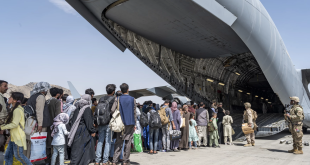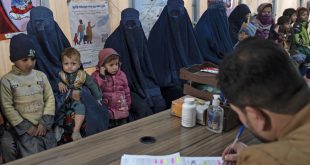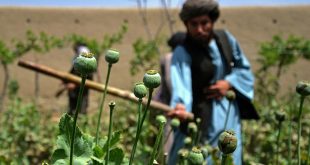By Wang Yu
Ambassador of the People’s Republic of China to Afghanistan
In recent months, Chinese President Xi Jinping has repeatedly stressed the need for China to form a “new development pattern centering on internal circulation with the domestic and international markets promoting each other.” To be more specific, China should continue expanding domestic demands, boosting consumption, advancing scientific and technological innovation and maintaining the security of its industrial and supply chains. Externally it should also continuously improve the business environment, strengthen the protection of property rights and intellectual property rights and foster expectations of a long-term stable development. In keeping with the trend of the times, President Xi took the initiative to plan for the profound changes in the domestic and international environment with China’s national conditions and strength, the international political and economic situation and global economic development in mind. On this basis, he has pointed to the need to focus on the medium-and long-term development of China, identified the direction for China’s economic and social development in the future and given his response to the tough issue of world economic recession. All people in China, the world’s second largest economy, are following in the footsteps of President Xi, actively addressing existing contradictions in the domestic market and speeding up opening up to the outside world at a higher level, which is expected to inject greater confidence into the world economy.
The new development pattern indicates an accelerated shift in the strategic focus of China’s economic development from being export-oriented to domestic demands-driven. Some people consider the stress on ‘internal circulation’ as a lead to closed-door economic operations. In fact, the opposite is true. Xi stressed that ‘the greater focus on the domestic market is by no means a closed domestic loop, but rather aimed at a stronger and more sustainable development based on a better tapping of the potentials of domestic demand, a better connection between the domestic and the international markets and better uses of both and their resources.’ On the one hand, the focuses in the two circulations are roughly the same, on the protection of intellectual property rights, improvement of business environment and reduction of access restrictions. And both must be based on a complete industrial system and adequate infrastructure. On the other hand, only mutually generating dual circulations can consolidate the position of the domestic market. And only through integrated domestic and international circulations, can we optimize the transnational allocation of production factors and expand the import of high-quality goods and services to meet domestic production and consumption needs and lubricate and add weight to the domestic cycle. International economic connectivity and exchanges remain the objective requirement for economic development in China and the world.
The move to advance both domestic and international circulations is designed to build up internal strength. Cross-border trade and investment have shrunk in the COVID-19 pandemic. China will continue developing more core technologies and brands with indigenous intellectual property rights, enhancing its capacity for independent innovation, consolidating its autonomy in economic development and improving its position and security in global supply chains, thus laying a solid foundation for high-quality development at home.
At the same time, to sustain the momentum for high-quality development, China must straighten out the production, distribution, circulation and consumption links of the domestic market to meet domestic demands. In this regard, China has a huge domestic market demand advantage. China has a population of 1.4 billion, a labor force of 900 million, more than 400 million people in middle-income group and over 100 million market players. According to an IMF forecast, the global economy will suffer a 3% negative growth in 2020. However, with a huge potential, high resilience, sufficient room for manoeuvre and many policy tools, the Chinese economy has moved steadily in work and production resumption and progressed substantially in many areas after taking the lead in recovering from the pandemic. Above-scale industrial added value rose 4.8% year-on-year for the fourth consecutive month in July, while retail sales rose 0.2%, the first positive growth since the beginning of this year. Even when China was worst hit by the pandemic and confronted with epidemic escalation risks and groundless foreign accusations and threats of economic sanctions, there was not any ‘wave of foreign capital withdrawal’. Instead, BASF, BMW, Volkswagen Group and many other companies continued increasing investment in China, a sufficient proof of the corporate world’s view of the size and safety of the Chinese market.
While the domestic market plays the central role in the new development pattern, a high-level opening up and the international market complement is also as part of the integral whole. Over the past 40 years of reform and opening-up, China has grasped the trend and taken opening-up as its basic state policy by pro-actively quickening the pace of integration with the rest of the world, thus winning a golden period of development. At present, albeit a slower growth of the dividend of globalized development, China still needs to reform and open up to forge the new development pattern and stimulate its potentials and advantages in international cooperation and competition in the new situation with the strong support of a higher-level opening up.
In today’s world, unilateralism and protectionism have caused a great clamour, but economic globalization still carries the historical currents. Cross-country division of labour and cooperation for mutual benefit and win-win cooperation still remain a long-term trend. China will steadfastly advance and lead economic globalization, strengthen international cooperation in science and technology, build a world-class economic platform and promote high-quality development within the Belt and Road Initiative to share its huge market opportunities with the world. China will also continue building a market-oriented international business environment based on the rule of law. Pandemic response did not stop the country from implementing its Foreign Investment Law, introducing the overall plan for the construction of Hainan Free Trade Port, shortening the Negative List of Foreign Investment Admittance, official announcing the dates of the 3rd International Import Expo … While strengthening itself, China has been accelerating the pace of opening up, with greater market opportunities for other countries.
At present and for some time to come, China will still enjoy a period of strategic opportunities. The door of China’s opening up will not close. It will only open wider. China will actively cooperate with all countries, regions and enterprises that are willing to cooperate with China. Afghanistan is China’s traditional friend and close neighbour. More than any other country, China hopes to see peace, stability, reconstruction and development in Afghanistan. We sincerely hope that the intra-Afghan negotiation will yield good results. This year marks the 65th anniversary of the establishment of diplomatic relations between our two countries. China is ready to carry forward our friendship, strengthen cooperation within the Belt and Road framework and make full use of sub-regional cooperation mechanisms such as the trilateral foreign ministers’ dialogue between China, Afghanistan and Pakistan to effectively tap the unique geographical advantages of Afghanistan and serve its economic interests. We will strengthen regional connectivity and extend the China-Pakistan Economic Corridor into Afghanistan and towards Central Asian countries. We will help Afghanistan to strengthen infrastructure, livelihood facilities and medical facilities and improve its business environment and people’s well-beings, including by building solar power stations, low-cost housing, universities and hospitals. China will expand imports from Afghanistan and help Afghanistan improve its manufacturing sector. China will, as always, firmly support Afghanistan in sharing more economic dividends in China’s new development pattern towards a community of shared future between us.
 Afghanistan Times
Afghanistan Times




